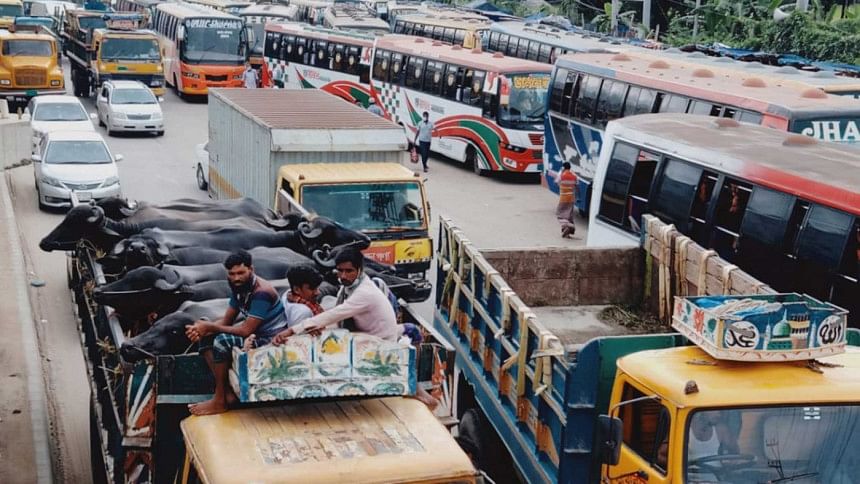There’s still time to save Gazipur

The Gazipur City Corporation (GCC) area has seen a fast population growth over the last two decades. The city's present population is estimated to be more than four million. With an area of 329.53sq-km, it is bigger than Dhaka North and Dhaka South combined. The GCC was established in January 2013. The city is one of our main centres of employment, industries, business, and entertainment partly as a result of its proximity to the capital city, which contributes about one-third of the country's total GDP and has about 30 percent of the country's total urban population.
Due to a wide range of economic and social activities, and a fast-growing job market, Gazipur city has attracted people from adjacent districts—especially from the rural areas. Therefore, in-migration is a major factor behind the growth of the city population. With the population growth, the demand for public utilities and services has grown manifold, but the city's infrastructure and services have failed to keep pace with that demand, resulting in a great deal of suffering for the residents.
About one-third of the ready-made export-oriented garment factories of the country are located in Gazipur. There are many other industries in the city as well: aluminium, textiles, leather, pharmaceuticals, cosmetics, ceramics, packaging, and others. The garment factories are employing hundreds of thousands of people—mainly women. Two export processing zones and the Tongi industrial area are located in the GCC area. A number of important public offices and facilities—including Bangladesh Agricultural Research Institute (BARI), Bangladesh Rice Research Institute (BRRI), Dhaka University of Engineering and Technology, Bangabandhu Sheikh Mujibur Rahman Agricultural University, National University, Islamic University of Technology, Bangabandhu Safari Park, Bangladesh Machine Tools Factory, and Bangladesh Ordnance Factory—are also situated there.
There is a large number of brick kilns on both sides of Turag and Bangshi rivers, and in the western and southern parts of Gazipur city, which are polluting the environment severely. Illegal encroachment of rivers, canals, and wetlands is also rampant there.
Millions of garment workers, rickshaw pullers and other low-income workers and their families live on the outskirts of the city, which are very crowded and have limited access to services and facilities. Besides, thousands of people who commute to the city on a daily basis face a tremendous traffic problem. Thousands of air- and water-polluting factories, workshops, vehicle repair shops and brick fields are located in and around these places, posing a risk to public health.
The GCC authorities, in recent years, have been putting in increased efforts to improve the condition of the city roads and drains. But the challenges of maintaining domestic water supply, street lights, sewerage, and garbage collection and disposal are enormous. There is also a lack of hospitals, schools, community centres, parks and shopping facilities. The city corporation's total budget was Tk 5,007 crore in 2020-2021 fiscal year, which has gone up four times to Tk 20,986 crore in 2021-2022.
To provide quality public services, first and foremost, a proper plan for land use is required, based on which the development of transportation network, civic services, appropriate environmental protection, and more healthy living options—such as greener surroundings, educational institutions, healthcare facilities, economic zone, parks and playgrounds, etc—should be undertaken. Since there is no master plan, the city's development along with its services and facilities is taking place in a haphazard manner. Most of the internal roads are very narrow and not maintained properly, and drains are mostly open. Many residents of the city travel to Dhaka to obtain basic services, such as medical treatment, shopping, schooling of their children, etc. In a city where it is difficult to move around due to traffic congestion, people waste inordinate amounts of time on the road to meet their day-to-day service requirements.
Some parts of the city have densely developed residential and commercial areas. Many land owners found it quite lucrative to build multi-storey buildings with the help of real estate developers. The vertical growth of the city, on the one hand, made it possible to house the upper middle-class families with affordable accommodation in developed areas; on the other hand, it exerted severe pressure on the existing infrastructure and services. The number of private vehicles, trucks and buses on Gazipur's roads increased manifold over the years, adding to the traffic gridlocks in the city.
Four national highways and six regional highways pass through Gazipur city, providing a crucial transportation network to connect to other parts of the country. The existence of a good road system has been the main attraction for investors in Gazipur. However, the transportation network needs further improvement to cater to the growing needs of people, and to transport products throughout the country. The work on the planned metro rail and elevated expressway projects should be expedited.
The GCC has recently taken an initiative to prepare an urban development plan that will take into account land use, drainage, and environmental management, traffic and transportation management, and industrial and recreational facilities. This plan should be comprehensive and drawn up to build a healthy city. A team of town planners, transport engineers, urban economists, geologists, hydrologists, water and sanitation engineers, environmentalists, agriculturists, waste management experts, civil engineers, architects, and sociologists should contribute to developing this plan.
The city still has a large geographical area under agriculture and forest coverage, which is highly likely to be transformed for other uses in line with the growth of population and establishment of new industries and businesses in the future. But the forest lands and water bodies should be preserved at all costs to keep Gazipur as an environmentally balanced city. If properly planned, there is a good prospect of developing Gazipur city in an aesthetically beautiful manner.
Dr Nawshad Ahmed is an economist, urban planner, and a former UN official.

 For all latest news, follow The Daily Star's Google News channel.
For all latest news, follow The Daily Star's Google News channel. 



Comments